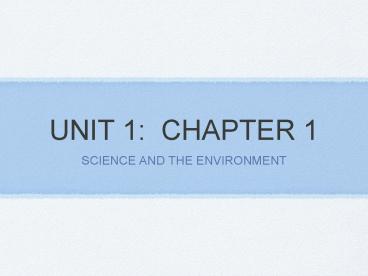UNIT 1: CHAPTER 1 - PowerPoint PPT Presentation
1 / 10
Title:
UNIT 1: CHAPTER 1
Description:
unit 1: chapter 1 science and the environment – PowerPoint PPT presentation
Number of Views:94
Avg rating:3.0/5.0
Title: UNIT 1: CHAPTER 1
1
UNIT 1 CHAPTER 1
- SCIENCE AND THE ENVIRONMENT
2
Section 1 Understanding our Environment
- Environmental science studies the impact of
humans on the environment. - goals understanding and solving environmental
problems - 2 focus areas (1) how we use natural resources
and (2) how our actions alter our environment - branches/fields of study (w/i env. science)
ecology, geology, chemistry, botany, zoology,
paleontology, social sciences...INTERDISCIPLINARY!
3
ENVIRONMENT...A LOOK THROUGH TIME
- Hunter-Gatherers
- fires, overhuntingstrategies!
- Led to Agriculture (collecting seedsartificial
selection, domesticating animals) began 10,000
years ago in various parts of the world. - Dramatic impact on societies and the
environmentcalled the agricultural revolution.
4
Lasting Effects
- Due to the replacement of forests, grasslands,
and wetlands with farmlands, long-lasting effects
resulted - Habitats were lost
- Soil loss (due to replacement of forests with
farms) - Floods (due to replacement of forests with farms)
- Water shortages (due to irrigation)
- Infertile soil (due to overfarming)
5
NextIndustrial Revolution
- Up until the mid 1700s, societies were powered
primarily by the work of humans or animalsthen
began the switch to fossil fuels (coal and oil). - Result increased efficiency and productivity of
agriculture, industry, and transportation - Less land needed for agriculturefewer people
grew their own food and urban populations
increased - Positive changes in quality of life invention
of the light bulb, telephone and the portable
computer sanitation, nutrition and medical care
improved - Negatives replacement of natural animal and
plant products with artificial substances (ex.
plastics, pesticides) most of environmental
science is concerned with the problems associated
with the IR.
6
Earths Problems?
- Earth is a closed system only energy from the
sun can enter and only heat energy can leave. - b/c some resources are limited, as the population
grows, resources will be used - more wastes are produced more quickly than we can
dispose of them (i.e. pollution) - Different scales of env. problems local
(property owners dispute about land use or pest
problem), regional (polluted drinking water), or
global (ozone depletion)
7
3 Main Environmental Problems
- Resource depletion occurs when a large fraction
of natural resources has been used up (renewable
vs. nonrenewable) - Pollution an undesired change in air, water, or
soil that negatively affects the health,
survival, or activities of humans OR other
organisms (biodegradable vs. non-degradable) - Loss of biodiversity extinction, species are
considered to be a non-renewable resource - Biodiversity the number and variety of species
in a given area.
8
Section 2The Environment and Society
- The Tragedy of the Commons by ecologist Garrett
Hardin published in 1968 - The problem in solving environmental issues is
the conflict that results from short-term
interests and long-term interests - Someone/group has to take responsibility for
mainatining a resource---otherwise the
resource(s) can become overused and then
depleted. - Long-term solutions and improvements have to take
precedence
9
Economics and the Environment
- Factors that influence how we use resources
- Social Pressures
- Supply and Demand (ex. production of oil and
pricechoices increase price, decrease use,
find new sources of energy) - Costs and Benefits
- risk assessmentimportant that the risk is
perceived accurately
10
Developed vs. Developing
- Developed countries having higher avg. incomes,
slower population growth, diverse industrial
economies, and stronger social support systems
(UN) - US, Canada, Japan, and the countries of Western
Europe - Use about 75 of the worlds resources but only
make up about 20 of the worlds population!
Why?...support quality of life - Developing countries having lower avg. incomes,
simple and agriculture-based economies, and rapid
population growth (UN) - Haiti, India, Chile, Mexico, Libya, Thailand
- 5.2 billion people live in developing countries
fewer than ½ have access to enough food, safe
drinking water, and proper sanitation. Result
malnutrition, starvation, disease, soil
infertility, animal extinction.































